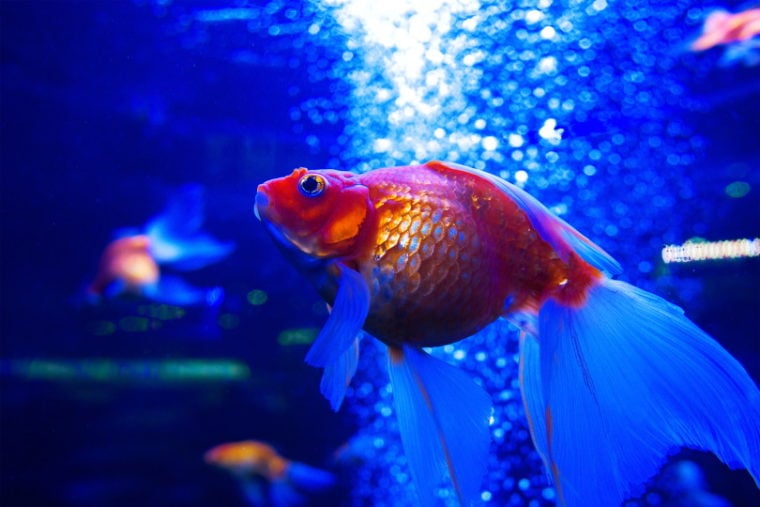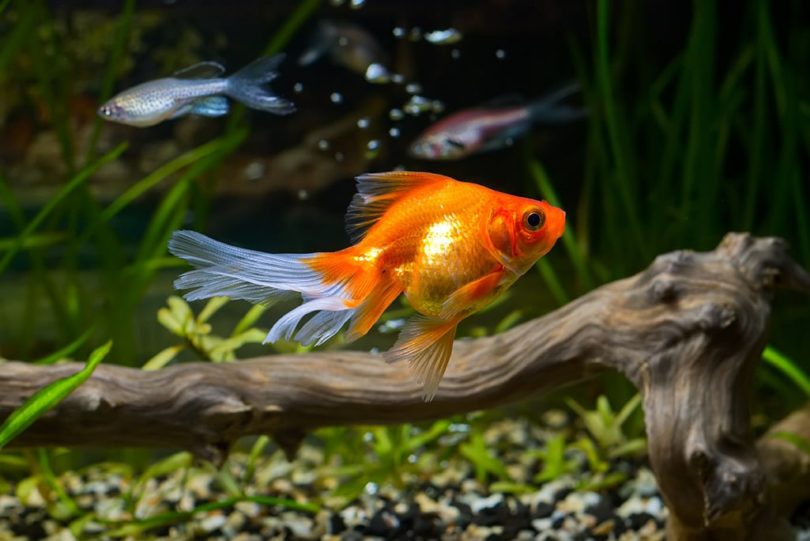
Some 1,600 years ago, the ancient Chinese began keeping goldfish. Wild, drab-colored fish were selectively bred to develop the vivid, vibrant colors of today’s fish. About 500 years ago, the Japanese acquired some of these fish and developed some of the more unusual types of goldfish seen today.
These days, there are dozens of different varieties available. All of them belong to one species, Carassius auratus, despite their different colorations, tails, bodies, and eye shapes. There is a special type of goldfish known as the Nymph Goldfish, which has a rounded body like a Fantail and a straight tail like a Comet. Unlike many other varieties of goldfish, Nymph Goldfish have only one tail. These fish are the products of recessive genes being passed down from both parents.
Quick Facts about Nymph Goldfish
| Species Name: | Carassius auratus |
| Family: | Cyprinidae |
| Care Level: | Easy |
| Temperature: | 65º – 75º F |
| Temperament: | Friendly, peaceful |
| Color Form: | Various combinations of orange, yellow, white, red, black, and red, yellow, and black |
| Lifespan: | From 5 to 8 years |
| Size: | Maximum 8 inches |
| Diet: | Gel food, pellets, flakes, granules, live or frozen food, roughage |
| Minimum Tank Size: | 5 gallons or at least three times the length of the fish in the tank |
| Tank Set-Up: | Filter, sand or large smooth rocks for the bottom of the aquarium, goldfish-friendly plants, decor, and hiding places |
| Compatibility: | Various peaceful freshwater fish that can’t fit in the goldfish’s mouth |
Nymph Goldfish Overview
Those new to fishkeeping will find Nymph Goldfish to be a great choice due to their hardiness in poor water conditions and tolerance of a wide range of water temperatures, as well as their widely available food and care supplies. There is a misconception that Nymph Goldfish live short lives, but with appropriate water quality and diet, they can live up to 8 years.
Though their basic orange-gold color may seem ordinary at first glance, they come in a range of warm hues, and watching their bright scales dance around an aquarium can be quite beautiful to behold.
In both indoor aquariums and outdoor ponds, Nymph Goldfish thrive. They can withstand temperatures from below freezing to 90° F or higher, but it is not recommended that you subject them to these temperatures over the long term. As long as they receive routine water changes and treatments to remove toxins, they can thrive in a wide variety of aquarium, pond, or bowl setups. Additionally, they require a high-quality, varied diet, as well as an environment that they find stimulating, such as tank mates or plants and decorations.
How Much Do Nymph Goldfish Cost?
The price of Nymph Goldfish varies depending on where you buy them and their type of coloration or pattern. The price of a Nymph Goldfish can range from $5 to $40 for quality specimens. Stocking your tank with these goldfish should not be too expensive, as a trio usually costs no more than $60. The bigger the Nymph Goldfish is, the more it will cost.
Nymph goldfish from a professional breeder will generally be more expensive since they come with a known genetic history and sometimes in much rarer hues and patterns.
Typical Behavior & Temperament
Typically, Nymph Goldfish are peaceful making great tank mates for other peaceful fish, but there are two exceptions to this rule. Male Nymph Goldfish can be extremely aggressive during the breeding season, chasing females until they are exhausted and injured. The second risk is when Nymph Goldfish are placed with small fish that can fit in their mouths. Fish fry, small adult fish, and other tank mates such as shrimp can be eaten by these fish. Both situations can be made safer by providing plants and hiding places.
Despite all that has been said about goldfish memory, they’re capable of recognizing you and playing with you through the tank glass by following your finger or ducking behind a plant to play hide-and-seek. Generally, they are very interactive, both with other creatures and with humans.
Appearance & Varieties
Nymph Goldfish are a type of fancy goldfish. Unlike the sleek body of other single-tailed goldfish such as comets, Nymphs have egg-shaped bodies with diaphanous, sweeping fins. With their long and delicate fins, and with their smaller size, they have an appealing appearance. Nymph goldfish come in a variety of colors, including calico, white, black, orange, yellow, and mixed patches of two or more colors.
Typically, nymph goldfish don’t grow to more than 8 inches, but pond specimens can reach even greater lengths, which is why you’ll sometimes see their maximum size listed as up to 20 inches.
How to Take Care of Nymph Goldfish
The following are some of the key points that you will want to consider before becoming a Nymph Goldfish owner.
Habitat, Tank Conditions & Setup
Tank Size
Although Nymph Goldfish can survive in bowls, aquariums, and ponds of at least five gallons, they need more space to thrive. Maintaining the quality of water in a smaller aquarium will require more frequent water changes. More spacious aquariums are also more stimulating for fish. Goldfish are also messy and to dilute the number of pollutants and waste they produce, all varieties of goldfish need a lot of water. A large aquarium is generally a better choice if you have multiple fish, such as a 20 to 50-gallon tank, depending on the number of fish you intend to house.
Water Quality & Conditions
Keep the tank away from direct sunlight and heat so that the water stays cool. Water should be between 60° and 70° Fahrenheit, with a pH between 7.0 and 8.4. Outside of these parameters, however, goldfish can become stressed and more susceptible to illness, although they are capable of surviving in a wide range of temperatures—if they can get oxygen through a hole in ice, they can survive below-freezing temperatures!
Torpor, which occurs when goldfish are in cold water, is a form of semi-hibernation. Their metabolism is greatly slowed during torpor, and they usually eat very little or nothing. Goldfish in torpor need good oxygen circulation in the water, so if your Nymph Goldfish are wintering in an outside pond, make sure you have a pump.
Substrate
Large pieces of gravel can get lodged in goldfish’s mouths, requiring human intervention to get them out to prevent injury or death. For this reason, a bare bottom setup is preferred by some goldfish keepers for ease of cleaning, but aquarium sand can also be used. River rocks can be used both indoors and outdoors if they are thoroughly rinsed before use and have no sharp edges to cause harm to fish. You should not collect rocks or plants from local waterways to prevent the transmission of diseases and parasites.
Plants
Live plants are eaten by all species of goldfish, which makes planted tanks unsuitable for Nymph Goldfish. That being said, goldfish are unlikely to consume plants such as Anubis, hornwort, java ferns, Amazon swords, and moneywort. Their favorite plants include duckweed, salvinia, and frogbit. Pothos, tradescantia, and bamboo can be grown from the surface of the water.
Lighting
Nymph Goldfish do not require heat lamps, but they require appropriate light cycles and they need an aquarium with normal day and night cycles. As a result, make sure to provide 12+ hours of light per day, with the remainder in darkness.
Filtration
A filter can collect larger debris floating in the water, such as waste and uneaten food. Also, filtration systems promote the growth of good bacteria within the aquarium, which prevents ammonia and nitrogen accumulation.
Are Nymph Goldfish Good Tank Mates?
While you can afford to keep quite a few Nymph Goldfish in your tank, you should be careful if pairing them with fish that are much larger. Nymphs are easily consumed by bigger fish, which view them as prey. Likewise, Nymph Goldfish may confuse various animals as treats. Both are possible.
Therefore, before you buy multiple little Nymphs, make sure your existing fish are compatible so you are not wasting money or putting your fish at risk. In general, nymph goldfish are peaceful fish that make good tank mates for platys, guppies, and danios.
Goldfish companions should be chosen based on how closely their needs are compatible with each other. As an example, goldfish prefer cooler water. Avoid tropical fish with higher temperature water requirements. Cichlids, which are aggressive fish, should be avoided since they can kill goldfish. In addition, mollies can nibble at the fins of goldfish, and Plecostomus fish can suck the slime coat of goldfish, leaving them vulnerable to parasites, so avoid both.
What to Feed Your Nymph Goldfish
In addition to fresh foods, Nymph Goldfish can eat manufactured fish food flakes. Nymph Goldfish can consume pellets and flakes daily since they contain all the nutrition they need. Be sure to additionally provide your Nymph Goldfish with a variety of fresh, cooked, or dehydrated foods.
Also, earthworms, bloodworms, and larvae are nutritious and your goldfish will happily eat live food snacks. Incorrect feeding, diet, or inadequate portion sizes lead to many goldfish deaths, which can be prevented easily with proper education.
Keeping Your Nymph Goldfish Healthy
Nymph Goldfish are at risk of contracting parasites and diseases, which is why you should quarantine all new fish for a few weeks. Goldfish Nymphs should be dewormed and treated with a comprehensive external medicine before being placed in the main aquarium. Every 3 months, goldfish nymphs that live in a pond outdoors must be dewormed. Every 2 months, Goldfish nymphs that eat live food and larvae should be dewormed. The Nymph goldfish should be treated right away if they show any signs of disease or infection. The earlier treatment is initiated, the higher the chance of survival.
To reduce the number of toxins in the water, weekly water changes are necessary. Water in the tank should be oxygenated by a good aeration system. Maintaining a comfortable temperature for your goldfish and removing waste from the water will keep them happy and healthy. It can be challenging to find a veterinarian who will care for goldfish, so start by calling exotic vets in the area for more information.
Breeding
Often, if Nymph Goldfish have been kept in cold water long enough to go into torpor, they will begin spawning when they are reintroduced to warm water. Usually, this involves females being chased, sometimes resulting in injury. Thus, separating fish, providing hiding places, or removing potentially hazardous décor may be necessary.
To increase the number of pheromones in the water, you will need to remove the charcoal from the filter when breeding your Nymph Goldfish. To increase the chances of egg fertilization, it is recommended to have a male-to-female ratio of 2:1, as well as 12 hours of light per day. Increased feeding may be necessary to stimulate egg production.
To prevent them from being eaten, fertilized eggs should be moved to a different tank. Even if the eggs survive with the fish, the fry will almost certainly be eaten.
Are Nymph Goldfish Suitable For Your Aquarium?
In conclusion, while Nymph Goldfish can be a beautiful addition to your aquarium, they may not be the best choice for all aquarists. Before adding any new fish to your tank, do your research and make sure they are compatible with the other creatures you have living there. With proper care, Nymph Goldfish can thrive in an aquarium setting and bring years of enjoyment to their owners. Be sure to consider the size of the other fish, their temperament, and the type of water conditions they need.
Nymph Goldfish can make a great addition to any home aquarium, but only if you provide them with the right environment.
See Also:
Featured Image Credit: Kateryna Mostova, Shutterstock









